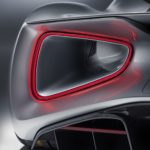- The Lotus Evija is the automaker’s first electric hypercar, and the first from Great Britain.
- With aggressive performance targets, the Evija would be the most powerful production car.
- Developed in concert with Williams Advanced Engineering, only 130 examples will be made.
If – and that is a very big if – Lotus is right about their numbers concerning their just-announced Evija electric hypercar, then Porsche can prepare to see their Taycan get blown so far off the track a bloodhound couldn’t find it. And forget about Tesla, the Lotus Evija could make them look like a bunch of pikers. Now, like I said, that’s a big if. And, to me, that’s one of the EV world’s biggest problems: this constant fudging about figures. It seems like every number on an EV spec sheet has an asterisk by it. That said, even if Lotus’ figures are off by a whopping 10 percent, the Evija will still be one of the best performing cars on the planet, let alone against the EV competition.
Lotus Evija: Power & Performance
The Evija’s four-wheel drive powertrain is slated to produce 2,000 PS or 1,972 horsepower, making it the most powerful production car in the world. Torque is 1,700 Nm (or 1,254 lb-ft.) with full torque vectoring (via four e-motors) for phenomenal handling. Power is produced by a 2,000 kW lithium-ion battery, mounted amidships. All up weight is 1,680 kg, around 3,700 lbs. Yes, that’s heavy for a Lotus, but light for an EV, especially with those power figures. And by these figures, the Lotus Evija has more power at each wheel than the total power of any other Lotus road car. Ever.
The performance figures add up to some impressive numbers: zero to 100 km/h (62 mph) in under three seconds; zero to 300 km/h (186 mph) in under nine seconds, and a top speed in excess of 200 mph. Put it this way: Count to three, you’re doing freeway speed; count to ten and you’re going faster than a fully-loaded 747 at takeoff. All this in about the time it takes a Camry Hybrid to hit 60.
Although we’re not through yet.
Flat-Out Power
Total range is 250 miles, and Lotus says power can be delivered over a sustained period of time. That’s a polite and British way of saying you won’t have to pussyfoot around at 32 mph most of the time to get that kind of mileage. Thanks to the car’s advanced aerodynamics and four-radiator cooling package for the battery, the Evija can be driven flat-out with no loss in power for at least seven minutes in Track mode.
Let’s put that into perspective. You can drive the Lotus Evija flat out for the amount of time it takes to lap the Nürburgring. In other words, the Evija will be the first EV that can compete directly with internal combustion cars over the same track. None of this BS 100 yard dashes and drag strip time trials.

Charging Units
“But who cares if it’s going to take me all night to charge it.” you retort. My response is don’t worry. Lotus, it seems, saved the Evija’s most impressive figure for last: Thanks to the partnership with Williams Advanced Engineering (yes, the Grand Prix team), the battery can accept a massive 800 kW charge. That’s more than twice the current industry maximum. Using existing charging technology, like a 350 kW unit, the Evija’s charge time will be 12 minutes to 80 percent, and 18 minutes to 100 percent. Compare that to how long it takes to fill up a normal EV now.
But it just gets better from there with the Lotus Evija.
Using Lotus’ 800 kW charger (which they haven’t unveiled yet) it will be possible to fully replenish the battery in just nine minutes. In other words, you can get a full charge with the normal equipment faster than you can eat lunch. With the high-power factory juicer, you can fill up the “tank” of your Evija in less than a coffee break. Lotus says they are talking with suppliers on additional charging solutions for customers.

Related: An in-depth look and technical overview of the Lotus Evija.
Pricing & Availability
The bad news, such as it is, comes down to the fact Lotus will produce only 130 Evijas, not coincidentally because this is Lotus’ 130th design, counting the Grand Prix and sports racers. So get in line now because the order books are open. Have that checkbook at the ready, because a £250,000 deposit secures a production slot (that’s around $300,000). The list price will be £1.7m plus taxes or around 1.9 million USD. For that handsome sum, Lotus will let you configure your Evija exactly as you want, down to the smallest details.
Oh, and in case you’re wondering, Evija is pronounced ‘E-vi-ya’ and means the first in existence or the living one. This carries on the Lotus tradition of naming cars that start with E – Elan, Elise, Esprit, Evora and so on.
Tony Borroz has spent his entire life racing antique and sports cars. He is the author of Bricks & Bones: The Endearing Legacy and Nitty-Gritty Phenomenon of The Indy 500, available in paperback or Kindle format. Follow his work on Twitter: @TonyBorroz.
Lotus Evija Gallery
Photos & Source: Group Lotus.

















